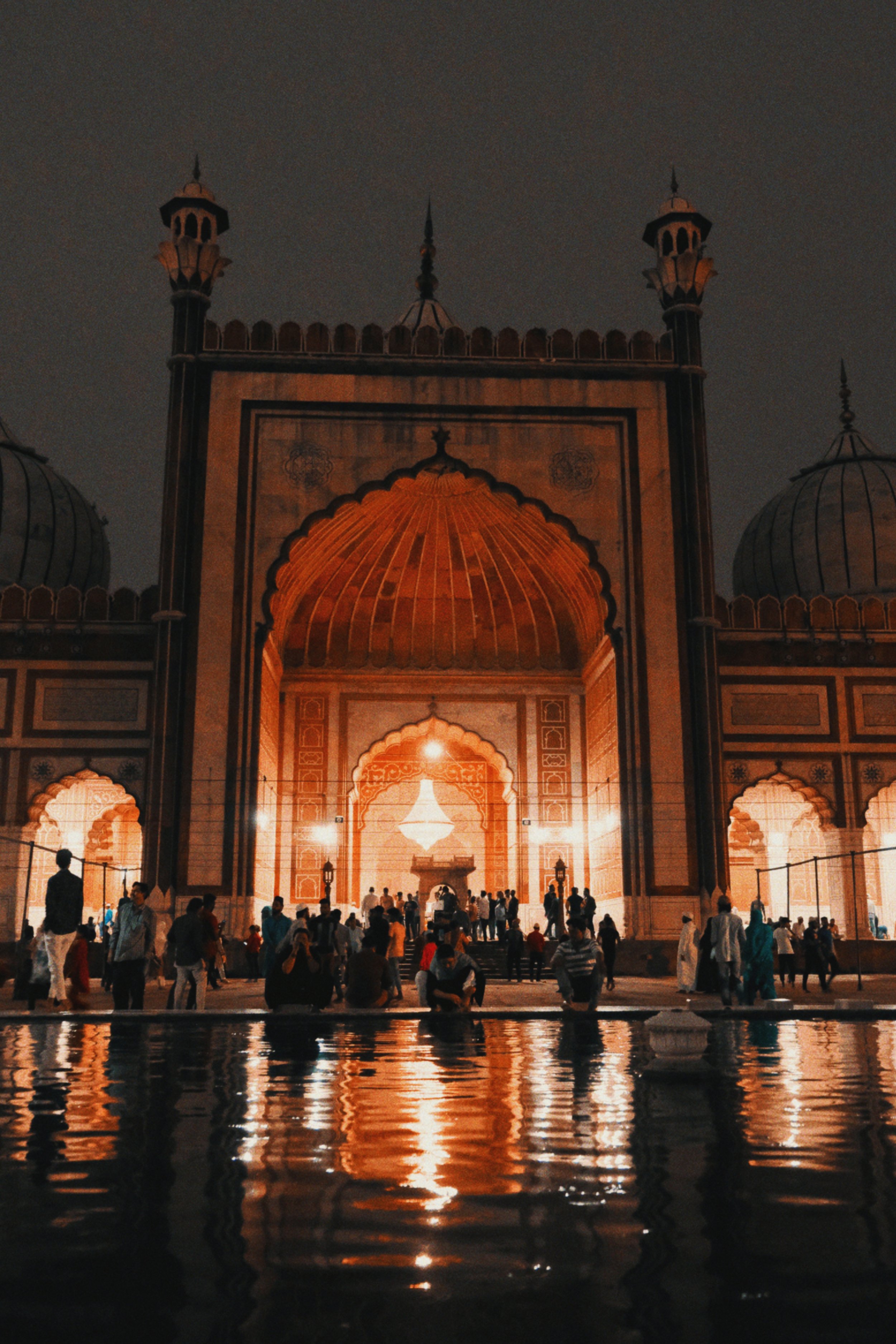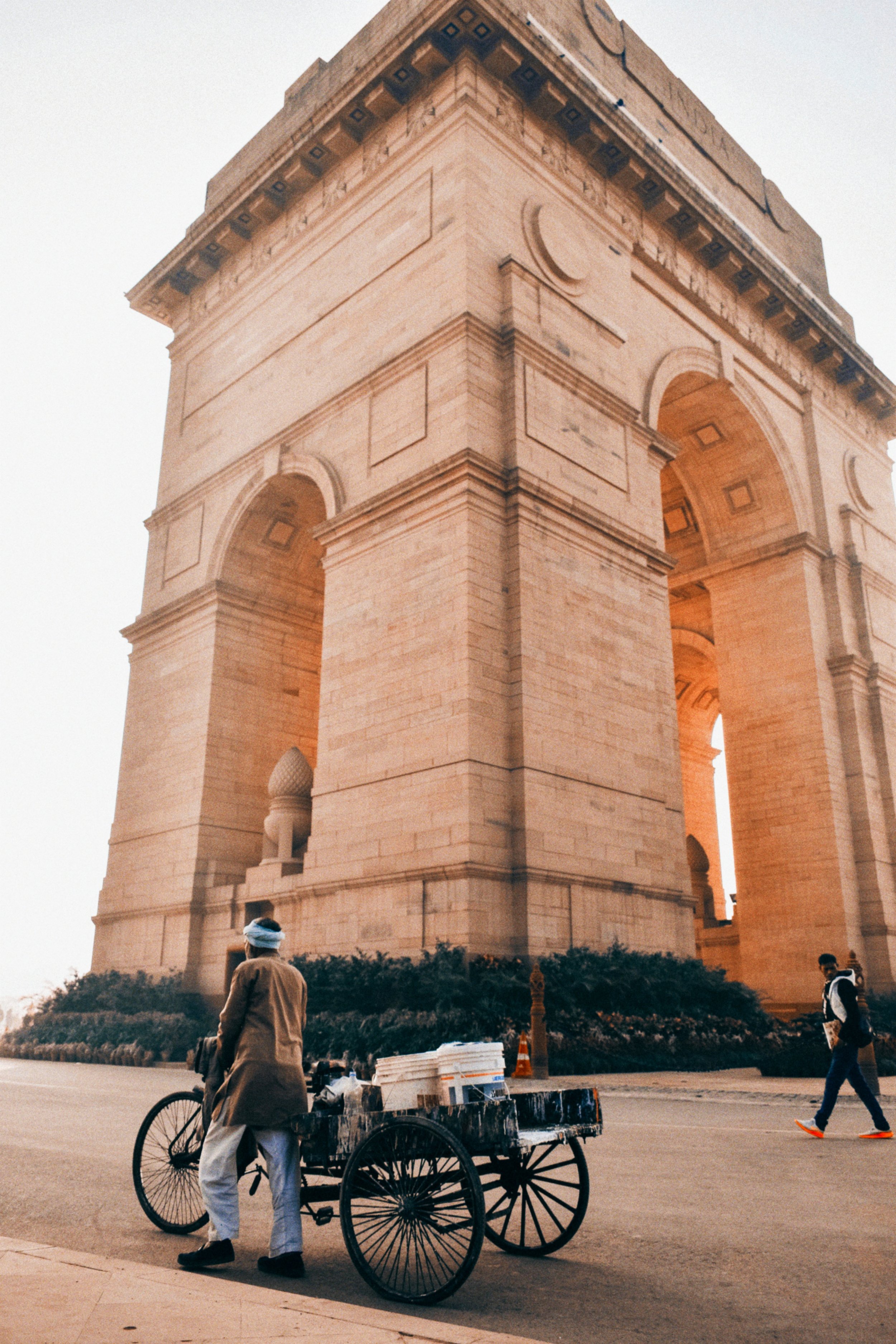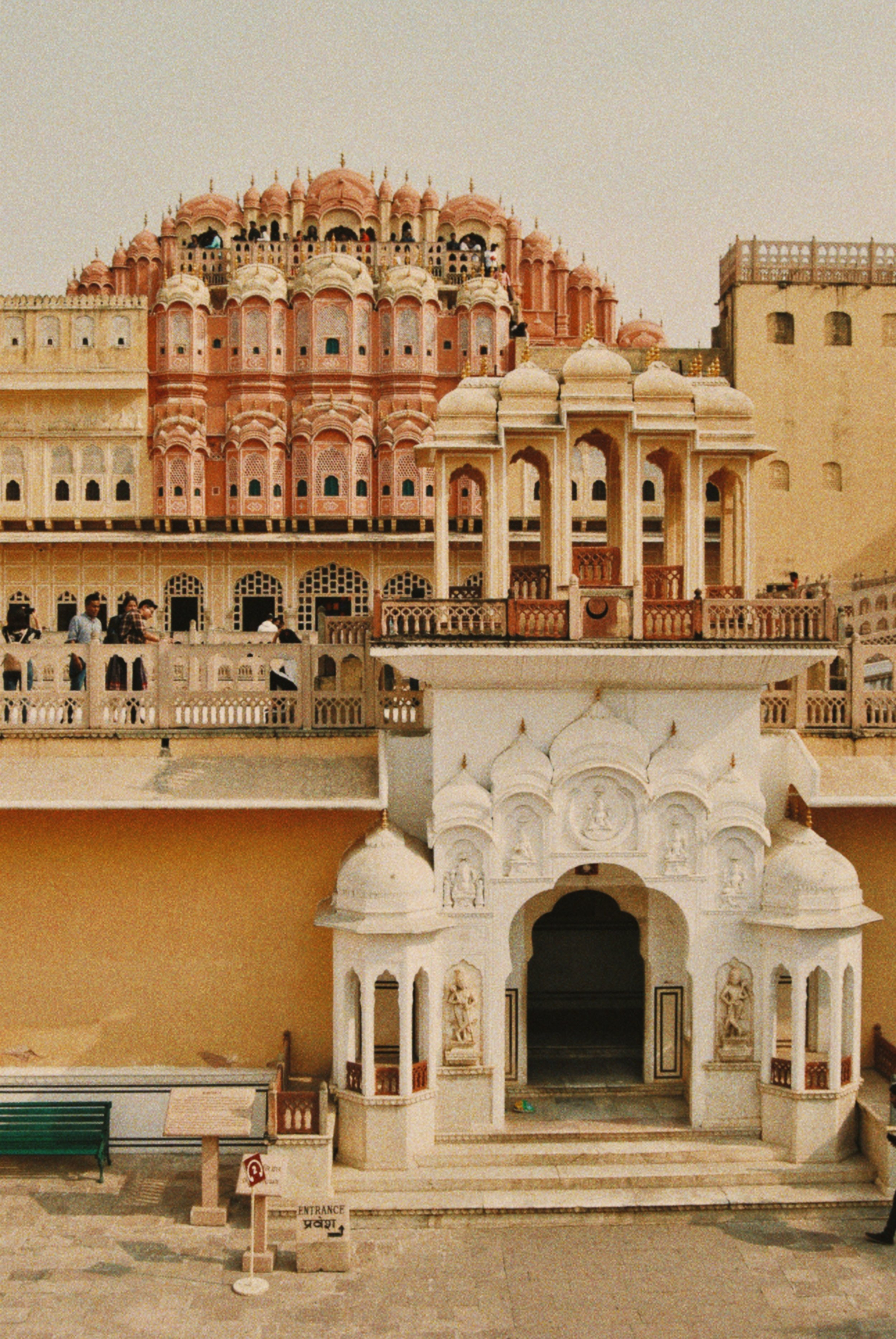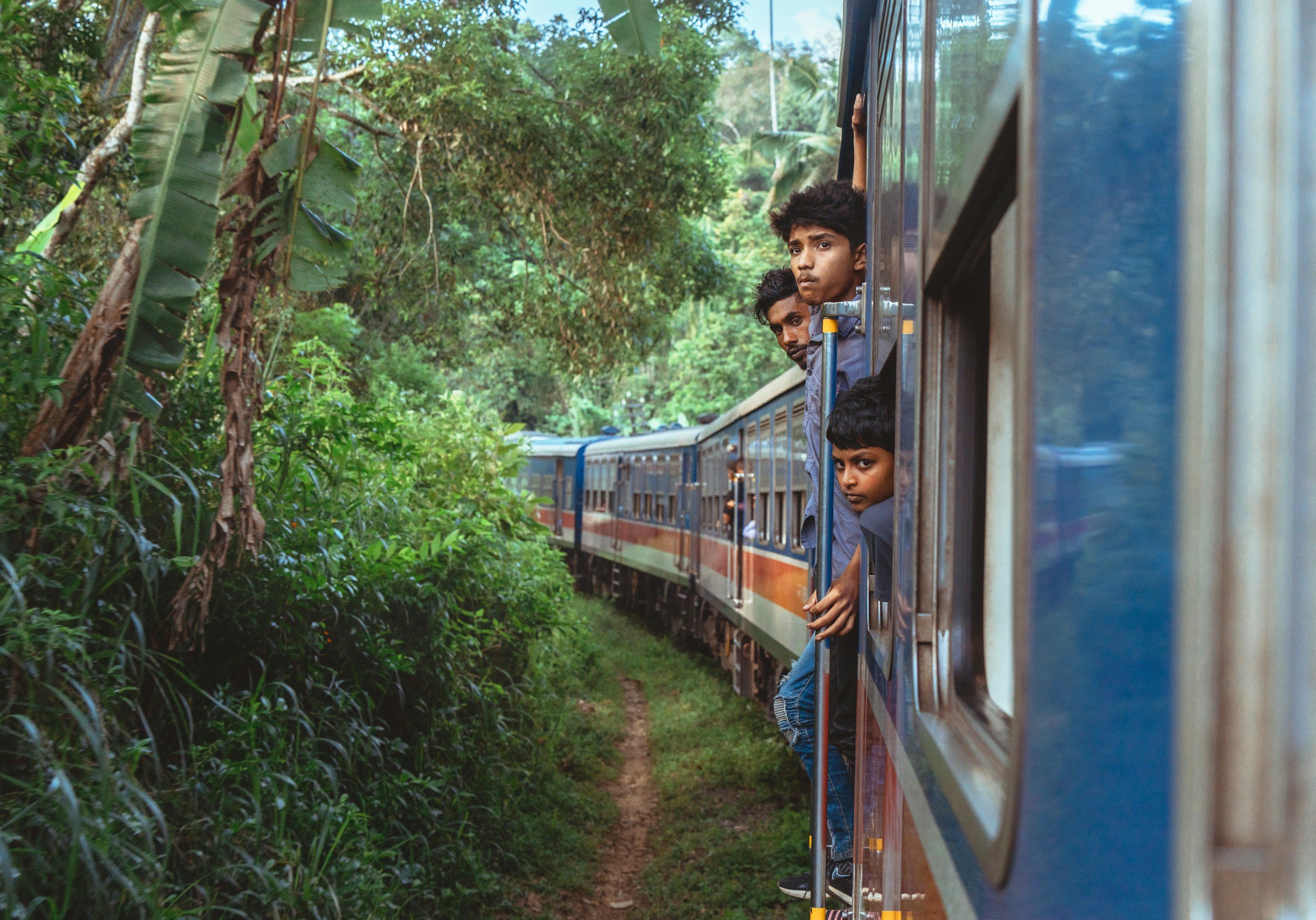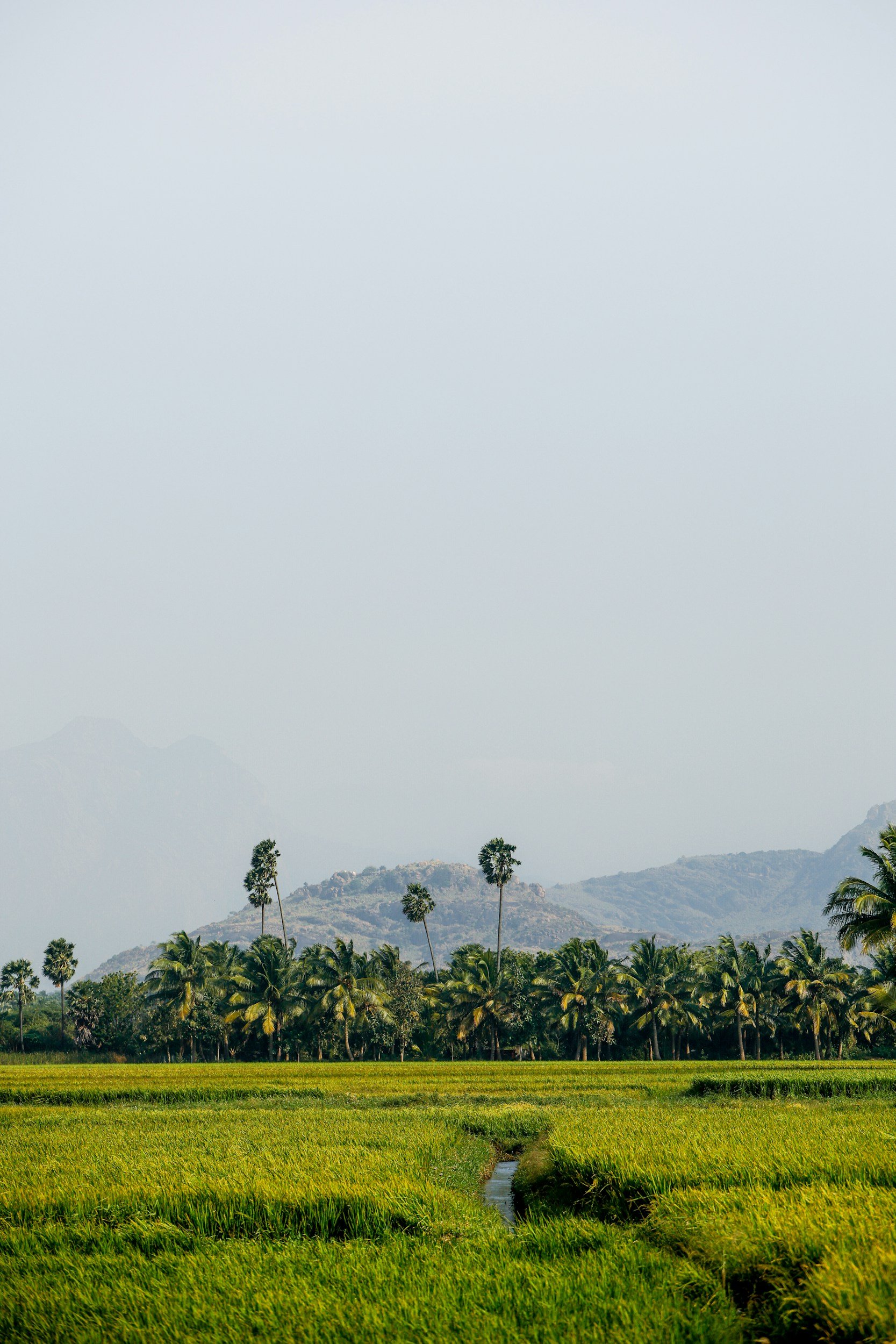Where Dust Meets Divinity: Tracing the Soul of India From North to South
Delhi was my first impression of a country that breathes in contradictions; where the air is thick with dust and devotion, and the roads move like a fever dream.
Cars, bikes, and rickshaws surge forward all at once, like no one’s quite sure who’s arriving or leaving.
In Old Delhi’s Chandni Chowk, I watched life unfold in a riot of colour and sound, the scent of masala and street incense curling through the chaos. The vibrant bazaar, a symphony of colours, fragrances, and voices, enveloped me as I was rocked bumpily through on a rickshaw, capturing fleeting moments and secret smiles.
At Masjid Mosque, I stood still while prayers rose like smoke into the sky, a hush settling over the city every evening. 375 years of history settled under my bare feet. The serene majesty of the largest mosque in India, its elegance commanding quiet reverence. Not far away stood the grand Red Fort, glowing in shades of fiery sandstone, whispering stories of Emperor Shah Jahan’s era.
New Delhi has its own rhythm, it truly revealed another facet of the city; wide avenues, lush gardens, and historical monuments. I walked through the quiet grace of the Gandhi Memorial, and felt something sacred. At India Gate, locals wandered and swam in the fountains and ponds, the heat stifling.
The Laxmi Narayan Temple offered peace and blessings of prosperity, while driving past Rashtrapati Bhavan, the President's residence, I admired its elegant fusion of Mughal grandeur and Western sophistication.
The light here turns everything gold. Qutub Minar looms in silence, the world’s tallest brick minaret, while Humayun’s Tomb cradles you in sandstone arms.
I dream in riddles and of hourglasses filled with the finest, most vibrant spices and I lose track of time entirely.
I have drunk copious amounts of aam panna under the afternoon sun and watched this new unknown world unfold.
Delhi was noise and nostalgia, dust and prayer. It unsettled me, humbled me, and will always stay with me.
And just like that, a journey had begun…messy, rich, and already unforgettable.
The doorways of Rajasthan felt less like entrances and more like portals; lotus flowers carved into stone, peacocks unfurling in dances of emerald and gold.
In Jaipur, the terracotta softness of the Pink City glowed under the desert sun, each heavy golden door a quiet guardian of past priestesses. In Jodhpur, arches bloomed like secret gardens, and the Blue City spilled out like a court of moonlit oceans, a maze as endless and shifting as the tides.
Each pathway breathed with devotion; every threshold hummed with history, secrets, and knowing. Whispers of maharajas and mystics, of battles and blessings, drift through the air.
The breeze found its way through spiraling sandstone, carrying echoes of a world that still lingers just beyond the veil.
And in the space between those whispers — between portals — I found myself alive, dreaming, quiet, curious, hopeful.
Leaving Delhi behind, I journeyed toward Jaipur, the Pink City of Rajasthan. Jaipur welcomed me warmly, wrapped in hues of pink symbolizing hospitality and charm. The city’s beauty lies not only in its colorful streets but also in its timeless traditions, as if every corner whispered tales of bravery, royalty, and legendary hospitality.
After settling into the hotel, an orientation tour introduced me to local traditions, including an elegant sari demonstration. Later, a cooking demonstration invited me into the aromatic world of Rajasthani cuisine. Under the guidance of an expert chef, I learned to blend spices and flavours, discovering culinary secrets passed down through generations. Sharing the delightful meal with local families made the evening not just delicious but heartwarming and memorable.
Jaipur's morning brought me to the majestic Amber Fort, a masterpiece blending marble and red sandstone, beautifully mirrored in the tranquil waters of Maota Lake. Standing on its terraces, I felt the grandeur of past kingdoms, absorbing views that felt timeless. Every spiral staircase and archway an invitation to time travel.
The regal elegance of the City Palace was jaw dropping, where architecture narrates a graceful blend of Rajasthani and Mughal cultures.
One afternoon, I wandered through Jaipur’s landmarks: the intricate façade of Hawa Mahal, which once concealed royal ladies as they observed city life, the fascinating astronomical precision of Jantar Mantar, which made my affinity of the stars and astrology felt seen and in awe. I stood in the near 42 degree heat mesmerised as the shadows grew by the second on what is the world's largest stone sundial, known as the Samrat Yantra. I traced my fingertips along the stone and whispered secrets to ghosts of the 18th century, “hello, I am from here, where are you now? fallen stardust or glowing embers…I still believe we’re here at the same time, somehow”
After Rajasthan’s fortresses, cities and maze-like explorations, I ran right into Ranthambore’s wild embrace.
The journey toward Ranthambore National Park unfolded like a storybook, a landscape shifting gently from bustling towns to rolling hills cloaked in whispers of wilderness. Ranthambore greeted me with the promise of adventure, nestled amid the Vindhya and Aravali hills, a realm where the ancient wilderness meets royal history.
Once the hunting grounds of Jaipur’s Maharajas, Ranthambore today is a sanctuary, fiercely protected as a haven for India's majestic Bengal tigers. The park spans over 1,300 square kilometers, but only 15% is open for treks—just enough to catch glimpses—depending what zone you’re in, and your luck. The anticipation hung thick in the warm afternoon air as I ventured on my first safari. With each rustle of leaves and distant call of wildlife, my heart raced with excitement.
In this world of tigers, Riddhi knows she’s the center of it all.
Fifth generation of the legendary Machali, the Lady of the Lake. Bold, untamed, and fearless, Riddhi once challenged her own mother for territory and now roams like royalty through Ranthambore’s wildest heartlands.
They say wherever she travels, it becomes the path itself—and it’s everything I want to be when I grow up.
Once a royal hunting ground, it’s now one of India’s most protected jungle habitats, where waterfalls, temples, and ancient ruins meet the wild. The jungle here breathes and whispers—thick with bush and the hush of stalking paws, echoing with birdsong and beneath golden sunsets that spill over the canopy like flame.
The park is near Sawai Madhopur in Rajasthan, where a 10th-century fort remains, and the Padam Talao Lake is known for its abundance of water lilies.
Later, exploring the Shabri Organic Dairy Farm, I stepped gently into the rhythms of local life. I sipped freshly made buttermilk, learned traditional tea-making techniques, and felt warmly welcomed into the community’s gentle embrace. That evening, as stars spilled across the vast Indian sky, I watched a short film detailing the inspiring story of Project Tiger, feeling deeply connected to the efforts preserving this incredible landscape.
The next day’s dawn safari revealed Ranthambore in gentle morning light—soft gold illuminating its forests, reflecting in serene lakes. The beauty of nature waking to life left an impression I’ll carry forever. Reluctantly leaving the wilderness behind, my journey turned toward Agra, a city immortalized by love.
Somehow, in what still feels like a dream…My first sunrise in Agra, I stood before the Taj Mahal as the first light spilled—and it felt undoubtedly like the beginning of something glorious.
The Taj Mahal was built as a monument to love ♥️ commissioned in 1631 by the Mughal emperor Shah Jahan after the death of his beloved wife, Mumtaz Mahal.
It took over 20 years to build, with over 20,000 artisans from across the empire coming together to bring it to life. Its design is perfectly symmetrical, 360 degrees—the layout of its gardens, balance of its minarets, the reflection in the waterways.
The only asymmetrical feature, is Jahan’s tomb—larger than his wife’s—when he was laid to rest beside her, 35 years after her passing.
The surrounding gardens were inspired by the Persian concept of paradise, charbagh. Symbolising the rivers of water, milk, honey, and wine flowing in heaven. Cypress trees (symbol of death) and fruit-bearing trees (symbol of life) frame the grounds.
The white Makrana marble glows like moonlight. Inlaid into it are precious and semi-precious stones (lapis lazuli, turquoise, jade, crystal, amethyst, carnelian) sourced from across the world: Tibet, China, Sri Lanka, the Arabian Peninsula. Through pietra dura, they form intricate floral patterns that shimmer like jeweled lace.
As I stood there, breathless, barefoot and in awe, I realized it’s not just a symbol of love lost, but of love remembered.
In the peaceful morning hush, I felt all the pieces of myself that I’ve carried through years and borders quietly settle, if only for a moment.
This is the most beautiful man-made thing I have ever seen. You can’t comprehend it until you share its presence. The grief and devotion that built it still linger in the air. Over 400 years old… and there I was, 30 years young.
I sat by Princess Diana’s bench. I cried. My head spun. My stomach filled with butterflies. I was alone yet anything but lonely.
I felt full—of wonder, of softness, of something older than time that chose to meet me here.
In all my joy, heartbreak, loss, fears, the whirlwind of life; I stood there and declared to myself that I am still the luckiest girl in the world and I vow to love and be brave in every moment.
The magic of the city of Agra is palpable, alive in bustling lanes, lingering aromas, and centuries-old architecture. Wandering through Agra’s hidden pathways on a food trail tour, you discover the most vibrant local flavours—from sizzling paratha to sweet, delicately textured petha, a sugary treat rooted deeply in the city's royal history. Sipping fragrant chai from clay cups as dusk painted the sky, I knew this place had captured a piece of my heart.
Agra Fort beckoned with its blend of strength and beauty, its red sandstone walls whispering tales of grandeur and intrigue. Each ornate carving and exquisite artwork spoke of a past rich in cultural fusion—Persian grace, European elegance, and Indian artistry merging seamlessly.
As the sun softened into evening, I visited Itmad ud Daulah’s tomb—the delicate “Baby Taj”—a marvel of intricate marble inlays, a quiet precursor to its grander counterpart. From the tranquil gardens of Mehtab Bagh, I watched the sun set gently over the Taj Mahal, colours deepening in perfect reflection, concluding my time in Agra with quiet reverence and lingering enchantment.
Varanasi cradled me like dusk cradles the last hymn of the day,
like the Ganges holds flame, without fear of being consumed.
Where breath dissolves into air,
and your lungs forget they were ever afraid to fill.
I drifted in, on, through—
old as the world, without a ripple.
Incense wound through the ribs of time,
curling into the mouths of gods carved from memory.
Ash softened the edges of each morning,
where dreams peeled open like lotus petals—
wet with silence and smoke.
The fire did not burn, it remembered.
It remembered every name I had shed,
every life I had unlived.
Bodies and bells,
chimes and chants wringing memory from my limbs.
Even the sky, smudged with ritual,
pressed its palms together
and watched me become undone.
No questions.
No answers.
Only the hush of being held
by something that has already wept,
already burned,
already risen—
again.
I exhaled,
and my breath became the wind
in which the birds drifted overhead, watching,
as spirits lingered, whispering, suspended in the quiet.
The closer this chapter of my journey appeared, the more pull I felt in my heart. It was a visceral pull, a question, and I answered wholeheartedly.
A city as timeless as the sacred Ganges flowing gently by its banks. Arriving in Varanasi felt like stepping into an ancient narrative, every street corner whispering stories of pilgrims, philosophers, and poets. Mark Twain once wrote that Varanasi is "older than history, older than tradition, older even than legend," and I felt those words deeply as I witnessed the luminous evening Aarti ceremony along the banks of the Ganges. Flames danced gracefully in the night air, their reflections shimmering in the sacred waters, creating an ethereal connection between earth and sky. Over 12,000 locals and travelers gather and upon chanting the prayers, the sound reverberated through my ribcage, so many hearts felt synced to a rhythmic, divine beat.
In the soft blush of dawn, I embarked on a boat cruise along the Ganges, its waters mirroring the waking sky. I watched life unfold on the ghats, an endless cycle of prayers, offerings, and quiet contemplation. Later, the city revealed more of its spiritual heart as I wandered through temples such as Durga Temple, Vishwanath Temple, Bharat Mata Temple, and the serene grounds of Banaras Hindu University. Each site carried a quiet dignity, echoing centuries of devotion.
An afternoon visit to Sarnath brought serenity and reverence. The place where Buddha shared his first teachings was profoundly peaceful, the Dhamek Stupa rising solemnly into the sky. Exploring the ancient Chaukhandi Stupa and marveling at Ashoka’s Pillar, crowned by the iconic Lion Capital, I felt deeply touched by the living legacy of wisdom and compassion preserved in these sacred stones.
The flight from Varanasi to the next destination felt otherworldly, I felt homesick for the Ganges and hum of the ancient before I even felt us take flight. From here, we travel more South, and the air becomes more humid, and the world more green.
Bangalore—now Bengaluru—hummed with modern energy. Like many Indian cities, it reclaimed its name to reflect local roots, joining others like Bombay to Mumbai, Madras to Chennai, and Calcutta to Kolkata.
Coming from the sacred fires of Varanasi and the sandstone palaces of Jaipur, Bengaluru felt almost startling in its sleekness. Glass towers dotted the skyline, and the streets teemed with tech startups and coffee chains, moving with a digital-era chaos…more honk than holy ;)
Yet, beneath the modern surface, the city’s history lingered, quiet settlements under South Indian dynasties, a key British administrative hub, now transformed into India’s tech capital. The past didn’t wear itself openly here; it hid in older neighborhoods and temples tucked between new developments.
To escape the sprawl, I found refuge in the botanical gardens; lush, still, and layered with greenery from sudden downpours. In that green, I found balance—an echo of the stillness I’d left behind, wrapped in the rhythm of somewhere new.
The journey onward to Mysore offered scenic tranquility, unfolding gracefully into the Jewel of Karnataka. Mysore felt like stepping into a royal past—tree-lined boulevards, ornate palaces, and a serene rhythm of life. Silk scarves adorned every corner and while exploring the majestic Maharaja’s Palace, I marveled at its splendid architecture, incredibly detailed mosaics, and grandeur that whispered stories of kings and queens, festivals, and music echoing through history. Mysore's charm truly lay in its elegant balance between past grandeur and gentle modernity.
One of my favourite days on this trip was indeed spent sitting on a rhythmic, 7 hour train ride that carried to Chennai, a metropolis by the Bay of Bengal. I felt as though I didn’t want to blink once, in fear of missing the world blurr past from day to the night. Fields of green, countless palm trees, villages, mountains and finally…the sea… Postcards in motion that I tried to memorise every contour of, every colour and layout and movement of people living their lives as I sat motionless, dreaming.
Chennai welcomed me with its serene beaches, golden sands meeting tranquil blue waters at Marina Beach (the longest shoreline in Asia!). The city's history was evident in its forts and palaces, each structure narrating tales of bygone eras and maritime legacies. In Chennai, life unfolded with a graceful calmness, harmonizing vibrant culture with soothing coastal breezes.
The air smelled of rose petals and marigolds, of dust and sea salt and a kind of holy warmth that stuck to my skin. The flower markets bloomed loud and fragrant—garlands stacked like silk ropes, petals scattered underfoot like confetti after a wedding. I wandered through the stifling heat of the city, where the sun beat down as if it had a personal stake in things. At Kapaleeshwarar Temple, the stone gleamed with centuries of devotion, the colours vivid, the gods almost breathing. Fort St George stood stoic in contrast, worn and watchful—a reminder of a different kind of history.
From Chennai, I followed the coast to Cochin, and something inside me softened. The sea felt even warmer here, less crowded, more of a whisper. I could feel it even when I couldn’t see it. The streets were wide and tree-lined, birdsong and green everywhere. I spent slow days exploring the Dutch Palace, the art on its walls whispering myths in ochre and charcoal. In Fort Kochi, I wandered by the water where the street dogs and kittens lazed in the sun—sandy fur, tails thudding gently against the ground. They made my heart ache in that way animals always do: pure, simple, present.
I really loved Fort Cochin. It reminded me of Thailand, a little. I visited an old, traditional ‘laundromat’ where time seemed to stand still, as well as a few Ayurvedic apothecarys. The churches I visited are built like upside down wooden ships and the old quarter was filled with the most beautiful little cafes and locally owned stores that made my jaw drop at the tapestries and stitching of scarves, blankets, jackets, dresses. I got my paws on some good linen here, for sure. I drank countless coconuts, I took deep breaths watching the waves, and I remember sitting by the shore and thinking that if peace had a temperature and scent, it would be this exact breeze and this faint trace of brine. I felt as though I was placed in a storybook, in some other time, in some other life.
The drive to Periyar was not for the faint-hearted; it was a call to the wild made up of hairpin turns that twisted like thoughts you can’t quite untangle. The altitude made my ears pop and the views of mountains as blue as the sea stole my breath in intervals. As we climbed, the air changed, too—cooler, more crisp. The jungle thickened, moss climbing trees like old secrets. When I arrived at the retreat tucked into the mountains, I exhaled something I didn’t know I was holding. Mornings came fog-draped, like the earth was still dreaming. Evenings roared with sudden rainstorms, thunder like distant war drums. At sunrise, I’d wake to the sounds of the jungle; monkeys chattering, birds crying, something primal calling just beyond the trees.
I visited a local spice garden and stepped into a world of scent and knowledge. Ginger, turmeric, pepper vines climbing up their stakes, cardamom pods tucked like treasure in leafy sleeves. Flowers with healing names, roots with ancient remedies. I touched bark that calms a fever, leaves that sweeten the air, herbs I’d only known dried in jars suddenly living and sharp in my hands. I tasted local coffee and tea, grown right there in the shade of the forest. Everything felt alive with purpose, and I wondered if the feeling of being there among the Earth like that was the closest I have gotten to hugging her.
On my last day in Periyar, I took a boat safari through a large reserve. The water was still and silent, until we saw them: a family of wild elephants, stepping softly through the shallows. One raised its trunk. Another waded chest-deep, utterly at home. Seeing animals in the wild, as thrilling as it is…makes me realise how happy I am to leave. As if I just want to get a glance of them, as they are meant to be, and then quickly return to the world as I know it. As if I so desperately want to protect their peace, I almost feel guilty for seeing them at all.
Alleppey, The Last Embers of Light
The descent from Periyar into Alleppey was slow and sunlit, winding down through green valleys and mist-soft air. And then, the water. The houseboat rocked gently as I stepped aboard—a floating cocoon of woven wood and quiet. The backwaters moved with a rhythm all their own, liquid mirror stretching wide. Villages floated past like dreams: laundry flapping, children splashing, life happening slowly. Boys dove from one riverbank to the other, all limbs and laughter, calling out and flipping mid-air like the water belonged to them.
As evening fell, someone strung together speakers from an old pole and plastic chair, music curling into the dusk like incense.
Dinner on board was nothing short of reverent. The chefs cooked with hands that knew exactly what to do—fresh seafood, spiced to perfection, delicate curries, soft rice, and in the morning, coconut pancakes that tasted like a lullaby.
The sun set ablaze over the canals, and for a moment the entire waterway looked like it had caught fire; flames dancing across the surface, fading slowly into soft violet night. The way the air smelled was intoxicating.
It was a perfume of stillness, a coccoon of safety as I fell asleep atop the boat. Alleppey made me feel the way I feel being held and swayed in my mother’s arms, of still feeling the way the waves rocked you after swimming in the sea all day, of the way you look around at your loved ones after dinner and love settles in your tired bones, of closing your eyes because hearing the sound of laughter in the next room is worth all your other senses.
My final morning, watching the mist roll over the water, I wished I could have stayed just one more day, and then another, and then another. Please, I pleaded, just one more breath in this drifting world.
Epilogue, A Thousand Lives in One
India never gives you just one version of herself. She opens like a prism, each city and state refracting light differently; some with a flash, some with a slow, sacred burn.
The journey, the story, the adventure…has been on a loop in my mind ever since my return. Words still do not suffice, but as this blog proves, I still do attempt for them to.
Delhi, where chaos is a constant companion, but not without pattern. There is a rhythm there, one that swings between the stately avenues of New Delhi and the dense, tangled devotion of Old Delhi. I moved through both like I was learning how to breathe again; through noise, spice, shadow, and incense.
Rajasthan unfolded like a painted scroll—palaces rising from the sand like mirages, every doorway carved and coloured, every wall telling a story. In Jaipur, Udaipur, and Jodhpur, I saw the past gilded in golden lotuses, glass mosaics, and echoes of royalty. And then I chased the call of the wild through Ranthambore, where tigers moved like ghosts through tall grass, and the dusty roads seemed to stretch forever beneath a red sun I swore I’d never seen anywhere else.
In Mysore, I felt a shift—less arid, more silken. The air was fragrant, the city crowned in elegance. I stood in the palace halls and ran my fingers across soft, shimmering silks, dyed in deep jewel tones, as dancers practiced outside to a beat older than memory.
Agra was a spell cast at sunrise. I arrived before the world was fully awake, and the Taj Mahal felt like a whispered promise. Eternal, aching, impossibly delicate. But it was Varanasi that became the prayer. There, along the banks of the Ganges, I saw fire meet water, and death cradle life without fear. The chants carried across the river like lullabies for souls. Something in me changed. Varanasi offered me her hand and I took it, and the letting go felt more of a return than anything else.
When I reached Bangalore, it felt like stepping into the present. Sleek and sprawling, yet I found pockets of stillness; solace in the botanical gardens, green shadows falling over stone paths, and time slowing again.
Then came the long, slow train south. Past the cities and into the palms. Chennai brought back the heat, but it carried the scent of rose petals and marigold, sea breeze and temples. Cochin soothed me; wider streets, green everywhere, the sea never far. I wandered the heritage lanes and made friends with street dogs who lived like kings beneath banyan trees.
And finally, Alleppey. The end, the exhale. Houseboats drifting through water-veined villages, where boys swam like fish and the sun set the world alight. I lay on my back under a thatched roof, music drifting from some makeshift speaker down the river, and I thought: this is how it feels to live a thousand lives in one.
In truth, I didn’t want to leave any of the places I experienced, I spoke of one to the next as if about friends, and reminisced the more the journey progressed. The tale as old as time of if you didn’t go there, you wouldn’t be here, and the unrelenting reminder of wherever you go, there you are. We must let go to hold onto another and we must cease resisting so that we can be changed.
To walk through India is to walk through time, to carry dust and mystery with every step, to be undone and reassembled by colour, sound, hunger, holiness. I went there hoping to explore and discover. I left with something far greater: I was seen with no expectation, I was held with no agenda.


















